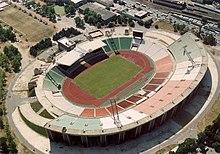Ferenc Puskás Stadium (1953)
| Népstadion, Puskás | |
 |
|
| Former names |
Népstadion ("People's Stadium") |
|---|---|
| Location |
Zugló, Budapest, Hungary |
| Capacity | 38,652 (before demolition) 100,000 (initially) |
| Record attendance | 104,000 (Vasas Budapest–Rapid Wien, 28 July 1956) |
| Field size | 105×70 m |
| Construction | |
| Built | 1948–1953 |
| Opened | 1953 |
| Closed | 2016 |
| Demolished | 2017 |
| Tenants | |
|
Hungary national football team Budapest derby (1973–1987) Zalaegerszeg (2002–2003) Debrecen (2009–2010) Ferencváros (2013–2014) |
|
The Ferenc Puskás Stadium (Hungarian: Puskás Ferenc Stadion), or formerly People's Stadium (Népstadion) was a multi-purpose stadium in the 14th district (Zugló) of Budapest, Hungary. It was situated between the Puskás Ferenc Stadion and the Keleti pályaudvar metro stations. It was used mainly for football matches. The stadium, which was an all-seater, had a capacity of 38,652, though its original capacity exceeded 100,000. The stadium was closed in 2016 and demolished in 2017 to give place to the new Ferenc Puskás Stadium.
The first plan of a national stadium were drafted as early as 1896 when there were chances that Budapest would host the first modern Olympic Games.
In 1911 Budapest was one of the frontrunners to host the 1920 Olympics. However, after Austria-Hungary's defeat in World War I, the Games were awarded to Antwerp instead.
The location of the first plan included Budapest XI. district and Budapest X. district.
In 1924 the government imposed a sport tax which was supposed to be use for the construction of a new national stadium, but finally this money was not used for the construction.
The stadium was built between 1948 and 1953 using a large number of volunteers, including soldiers. It opened in 1953 as Népstadion' ("People's Stadium"). Less than one year later, on 23 May 1954, the English football team suffered its worst ever defeat here (7–1).
...
Wikipedia
